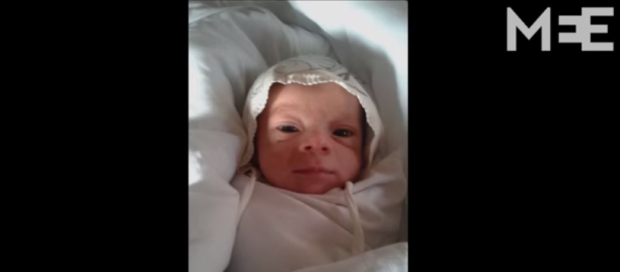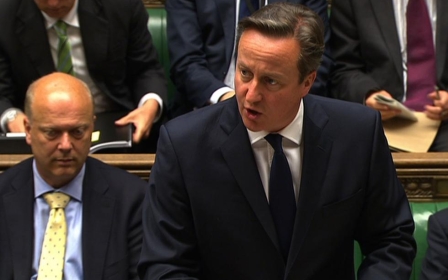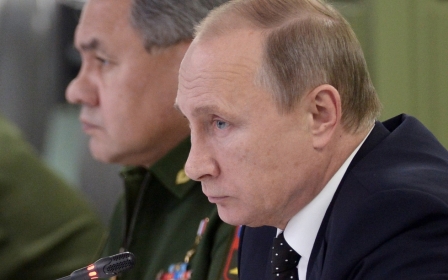EXCLUSIVE: US accused of covering up death of six children in Syria air strike

A Syrian father has accused the American military of attempting to cover up the deaths of six of his children and the serious injury of two others in a US-led coalition air strike.
Standing amid the rubble of his former home, Muawiyya al-Amouri told Middle East Eye that six of his children, aged between 10 months and 10 years old, and three members of a refugee family sharing their house, had died in the attack near Atmeh, a town close to the Turkish border, on 11 August.
“A plane belonging to the alliance shelled my house with six missiles. They destroyed my house and my children died. I had some refugees in my home from Ariha [near Idlib city] who died as well,” he said.
US Central Command confirmed that the coalition had carried out an air strike in the area as part of its campaign against the Islamic State (IS) group and launched an investigation into possible civilian casualties following media reports at the time.
The incident was also the subject of a report by the Syrian Network for Human Rights, a UK-based monitoring group.
But in recent emails, US military spokespeople told MEE the investigation had concluded that allegations of civilian casualties were "unfounded" and said the strike had targeted an IS "staging area".
"After careful review and based on the best available evidence, it was determined that allegations of civilian casualties by the coalition were unfounded and deemed not credible," said Centcom spokesman Kyle Raines.
Yet al-Amouri, who was not in the house at the time, said that five of his daughters had been killed: Fatimah, aged 10; Hayat, aged nine; Amina, aged seven; Asia, aged five and Marwa, aged four; as well as his 10-month-old son Abdullah.
He also identified the three members of the refugee family who were killed as Umm Tawfiq, her son Yusuf Yaseen, 25, and daughter Fatima Yaseen, 17.
Al-Amouri's two surviving children, Ali, aged five, and Nariman, aged two, were pulled out of the rubble with serious injuries. His wife also suffered injuries including a broken arm and leg.
He said his son had required several operations for head injuries and had spent a month in hospital, while his daughter could no longer walk, was blind and could not speak.
"She used to walk and talk, she had no problems. Now her legs are as you can see. I don't know what is wrong with them. She doesn’t speak, doesn’t see, and I don’t know what to do for her," he said.
Asked what his message was to those he believes carried out the attack, Al-Amouri said: “I would say to them, Allah is enough for us as a disposer of our affairs. We hadn’t even finished with Bashar [al-Assad, the Syrian president] and then the alliance [the US-led coalition] came. I am charging the alliance and I am suing them. I’m a civilian and six of my children were killed, my house was destroyed and now I have nothing.”
A doctor who was on duty at a nearby hospital on the night of the air strike, who did not want to be identified, told MEE that he had initially feared the hospital was being targeted because of the force of the explosions.
“Around 8:15pm we felt and heard the powerful blasts,” he said. “Approximately 15 minutes later casualties began coming in. There were three hospitals that the injured were brought to. Fatima Yaseen [one of the refugees] was brought to our hospital. She died of her injuries shortly after her arrival.”
Al-Amouri and other local residents also rejected US claims that IS had been present in the area.
Asked by MEE to clarify what the target of air strike had been, Centcom spokesman Major Tim Smith wrote: "The target was a Daesh [IS] staging area in the vicinity of Atmeh. And it was a successful strike by the Coalition.
"The Coalition takes a lot of time and research into developing our targets to ensure maximum effect against Daesh and to minimize the potential for civilian casualties. No evidence links casualties or injuries to the Coalition air strike."
But Al-Amouri said: "IS hasn’t been in this area for approximately two years. This is my house. My home. It was occupied by me, my children, some refugees. All civilians."
IS not in area of strike
Sources in Atmeh told MEE that IS had been forced out of the town by local rebel groups in early 2014 after setting up checkpoints where some residents had been shot, and attempting to take over local mosques.
Initial reports of the air strike had suggested that the main target had been a nearby building used as a headquarters and munitions factory by a rebel group originally from Homs known as Jaysh al-Sunna. The UK-based Syrian Observatory for Human Rights reported that 10 fighters as well as civilians had been killed.
But Tauqir Sharif, a British aid worker based in Atmeh's nearby refugee camp, told MEE that all the victims he had seen had been civilians. He was a few hundred metres away when the missiles struck and helped to pull bodies out of the rubble, he said.
"In the factory nobody was killed. They didn't kill any soldiers or military personnel. The warehouse was clearly a warehouse and the house was clearly a civilian house. It was very precise, they targeted that house. There was nothing left," he said.
“The strike was at sunset and we were digging all night to take people out of the ground. The last child was taken out at about 5.30 in the morning. It was all in darkness. We were using torches."
Sharif said that local residents did not know why the coalition had attacked a group with no affiliation to IS or Jabhat al-Nusra, the al-Qaeda-linked group it has occasionally also targeted, including in a previous air strike in Atmeh in March.
"I'd never heard of this group, Jaysh al-Sunnah, until the strike. I didn't even know they existed in Atmeh," he said.
He later learned rebels were making mortar bombs and distributing them to different groups to use against President Assad's forces.
Atmeh and the surrounding area has been relatively safe since the start of the Syrian conflict in 2011 because its proximity to the Turkish border has protected it from air attack by government forces, drawing thousands of Syrians displaced from elsewhere in the country.
"This has always been known as a safe zone but it has created a sense of fear," said Sharif. "Many locals are saying the reason the Americans did this is they don't want people to help the rebels. People are afraid now to help the rebels, because here they just want a safe place to live."
Doubts over Centcom probe
Centcom's response to MEE also appears to raise questions about the rigour of its inquiries into the Atmeh strike. At the time, it had initially denied reports of the attack, but later said that had been due to confusion over the spelling of the town's name.
Asked what evidence investigators had considered and whether they had sought to contact witnesses in Atmeh, Major Smith wrote: "When comparing what was reported to be eyewitness reports, photos of the scene, photos of the casualties at the scene, and the various social media videos and pictures to coalition target imagery, the assessment found significant contradictions. Most glaringly is the fact that there are no pictures that show casualties at the strike location."
Aleji Wael, a spokesman for the Syrian Network for Human Rights, told MEE that the US military had not contacted the organisation despite its report into the attack, and said he was surprised it had dismissed reports of civilian deaths.
"If they say that they have initiated an investigation into this incident I would imagine that they would get in touch with the people who reported it," he said.
"We are confident that it was a coalition strike. Our team of researchers have interviewed and spoken to eyewitnesses and victims of the strike. I would encourage the US authorities to show evidence of this investigation and publish the results so we are informed about what they think."
The US military, which has conducted about 95 percent of more than 2,800 air strikes in Syria since the beginning of Operation Inherent Resolve against IS last September, has so far published only one report acknowledging civilian casualties in Syria; two children it said were likely killed near Harem in Idlib province in November 2014.
On Friday, the US also said that four civilians had been killed in a coalition air strike against an IS checkpoint near Hatra in Iraq.
In July, the coalition bombing campaign was described by Lt Gen Charles Q Brown Jr, the commanding general, as "the most precise in the history of warfare". But monitoring groups have accused the coalition of killing hundreds of civilians in both Syria and Iraq, and of failing to properly investigate reports of casualties.
Jennifer Gibson, a lawyer at the human rights organisation Reprieve which has taken legal action on behalf of civilian victims of drone strikes, called for the US to launch "proper, public investigations into dozens of credible claims of civilian casualties".
"We’ve seen this time and time again in the war on terror. The US wages a 'precise' air campaign and claims little to no civilian damage. Yet, the realities on the ground paint a different picture. They paint a picture of faulty intelligence, shattered lives and terrorised communities who are left with nowhere to turn for answers," Gibson told MEE.
"The reality is that the US quite simply has no idea who it is killing. This lack of transparency is the hallmark of a US counterterrorism approach that fires missiles based on faulty intelligence and no accountability."
New MEE newsletter: Jerusalem Dispatch
Sign up to get the latest insights and analysis on Israel-Palestine, alongside Turkey Unpacked and other MEE newsletters
Middle East Eye delivers independent and unrivalled coverage and analysis of the Middle East, North Africa and beyond. To learn more about republishing this content and the associated fees, please fill out this form. More about MEE can be found here.





